Slate Countertops (Design Guide)
Slate countertops are a great choice in all categories; aesthetics, price, and quality. There are many locations where these countertops can be used as well as a wide variety of colors that can be chosen.
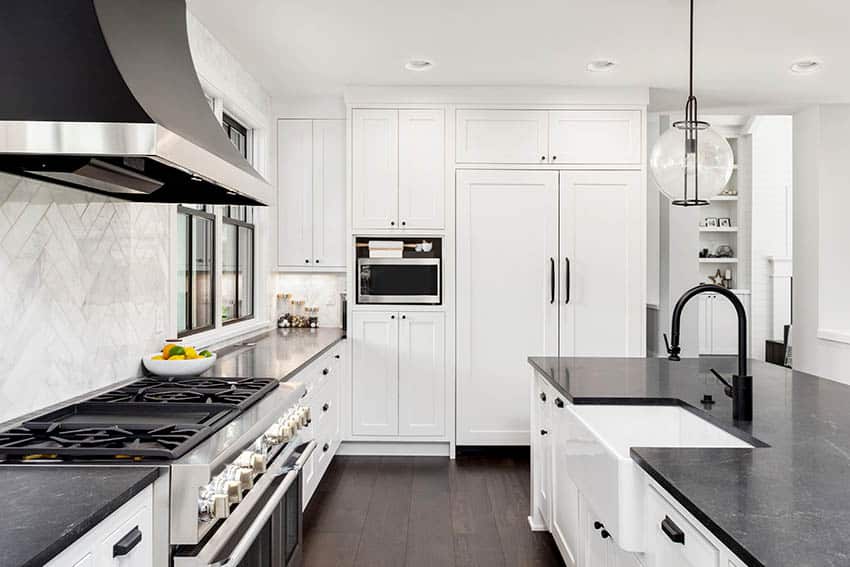
The go-to when thinking of natural countertops is commonly granite or marble. However, introducing a slate countertop can be the best thing you can do for your budget as well as adding a unique statement piece to your kitchen or bathroom.
Characteristics of Slate
Slate is a natural material that can be used for a number of applications, including kitchen countertops. It is similar to natural soapstone in its makeup and qualities.
it is made up of a few natural materials, such as clay and silt, etc which can vary causing different appearances as well as performance quality. This stone is created over millions of years of pressure and temperature changes to create a distinctive appearance.
The performance quality is based on the grade (high, medium, low); this typically correlates with the price range. This material can be extremely durable, nonabsorbent, stain-resistant, and not easily scratched.
Turn around to the lower grades and they can be the exact opposite; weak, porous, easily stained, and easily cracked. When looking to use natural stone for countertops, the higher grades that can be sealed are used. This material comes in a variety of colors and natural patterns.
Where to Use Slate Countertops

These can be used in a number of places. Kitchen countertops and bathroom countertops can become home to the beautiful slate countertops of your choosing.
These countertops can also be used at exterior bars and counters as well as other islands or residential applications. This material is extremely versatile and can raise the value of a home when used.
In places with more water present, it is important to go with a higher grade so that the surface is non-absorbent and will not be ruined by any spilling. This is common in both kitchens and bathrooms. Each is described in more detail below.
Slate Kitchen Countertops
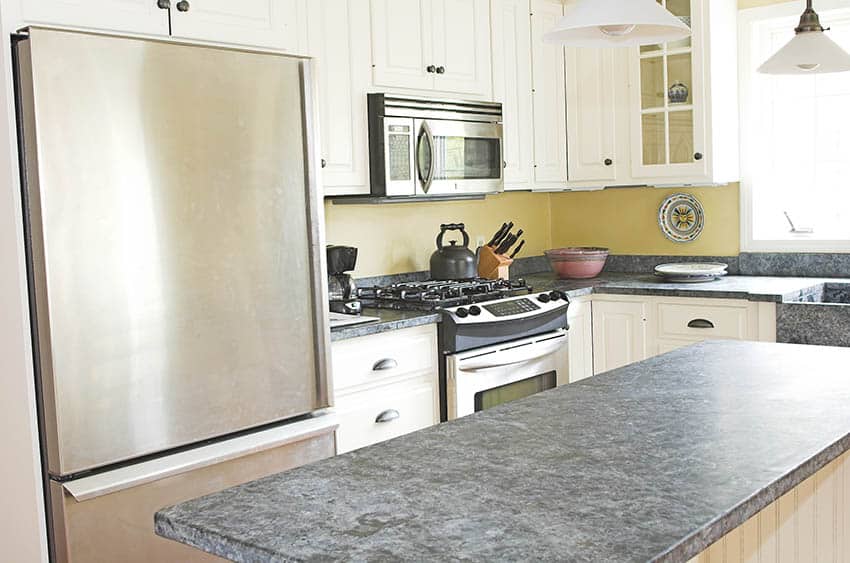
This material is a fantastic choice for a natural material for kitchen countertops. It ranks up there with marble and granite while being almost half the cost. Though it costs less than other natural stones, it still costs more than man-made materials such as laminate or solid surfaces.
Slate has a natural, cleft texture (slightly irregular from cutting) that can add depth and interest to your kitchen. However, for those who prefer a smoother surface, honed slate is also an option. Edge detailing the slabs can further enhance the surface design and profile of the material. For a modern appearance, use a straight edge and to go more traditional use a bullnose or an ogee edge.
It can be pretty uniform giving a clean look to the space while giving a nice unique appearance. This material offers a great amount of durability that is needed for a high-use area such as the kitchen. To bring out more of the stone’s beautiful characteristics pair it with under-cabinet lighting to highlight the color variations and textures.
These kitchen countertops can resist heat from pots and pans, moisture from spills, and stains from food or liquids.
Slate Bathroom Countertops
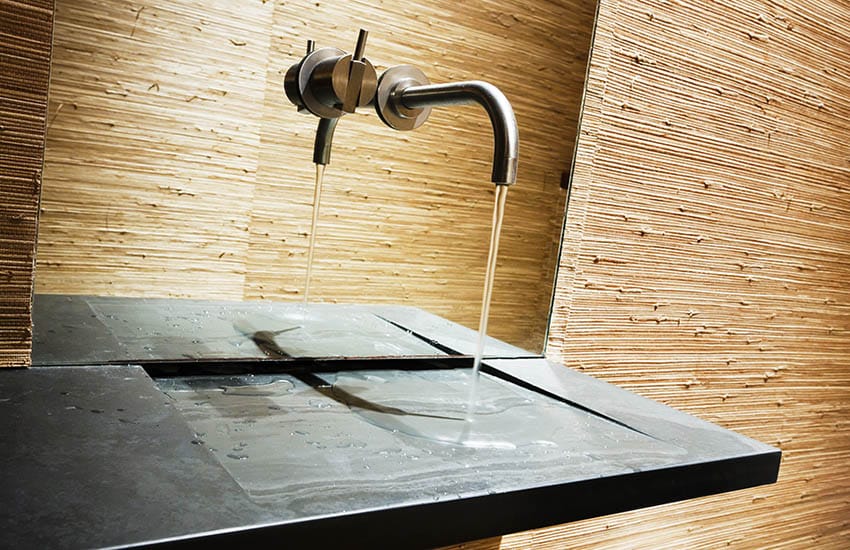
These countertops can be and are commonly used in bathrooms as the vanity top. This is a great choice, if the right grade is selected.
It can be resistant to any heat from curling or flat irons that may be used for bathroom countertops. Additionally, this material can withstand the water from the sink as well as any makeup or soap stains that may try to ruin your surface.
Though the surface is easy to clean, a great deal of maintenance comes with keeping up a natural material such as this rock. Keep that in mind when considering installing it.
Slate Slab Colors
Choosing the color of your stone slabs can not only effect the appearance of the countertops, but also the cleaning requirements as well as the price.
Typically the darker the color the higher the price of the material, as it effects the strength and quality of the stone.
Making this selection carefully can make sure you get the right countertop color the first time. Below are a few of the most common colors for counters made of this material.
Black Slate
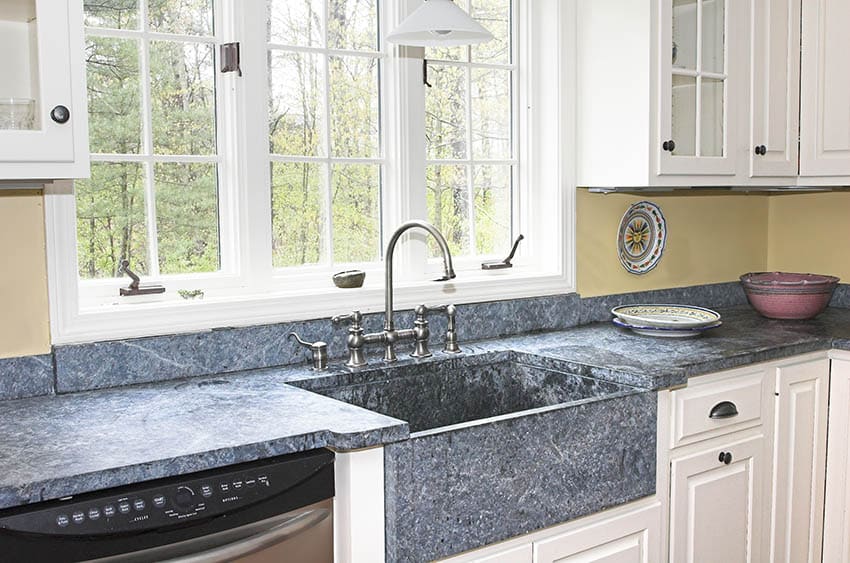
This material is also known as chalkboard slate. This is because it can be used just like a chalkboard if it is not finished.
It is in the higher price range than some of the other colors. It, in particular, is striking and beautiful but can show imperfections and stains more than some of the other colors, especially if it is unpolished.
This being said, the black variety is extremely durable and can be used in a great deal of settings.
Gray Slate
Gray slate countertops are in the lower to middle section of the price range. It is commonly dark in color with some marbling in appearance.
This is where we get the term ‘slate gray’ when it comes to determining shades of gray. This gray stone, which has a darker color, has good durability and strength.
It is one of the most frequently used pieces for counters. Similar to the black variety, the gray variety is also prone to showing staining and fingerprints.
White Slate
There really are no true white slate counters. What could be considered as white is typically not purely white, but instead is marbled or speckled with some of the grays or blacks to give a more visually intriguing design.
These counters are susceptible to stains and visible dirt due to their light color. These counters are in a similar price range as the gray colored kitchen surfaces, middle to lower.
Other Slate Color Varieties
While we covered the most popular, more neutral colors, there are a variety of colors that can be selected from.
As the stone is natural though, there is a limit to the colors that are available since they are by definition, part of nature. Some of the rarer and more unique colors are as follows:
Green, purple, or red: These are rarer colors found in Vermont and are highly priced due to their strength, visual appeal, and rarity. These colors are absolutely stunning in appearance and are very limited, they are used in only the most elaborate of projects.
Gray-blue: Basalt is a blue-gray color that can have a lot of variety in it. Basalt is a middle to lower price point as well as quality level.
Blue: Blue slate has more of a drastic blue color than basalt, and can come in a variety of different colors of blue. The former is a middle to lower quality level and a price range.
Browns and greens: Brown and green varieties are typically from regions such as Colorado. Rustic and African slates, in particular, offer a warmer selection of colors.
These colors are in the middle to higher price range as they are rarer and more unique even though the quality is not as top of the line as some of its competitor colors.
Slate Installation Costs
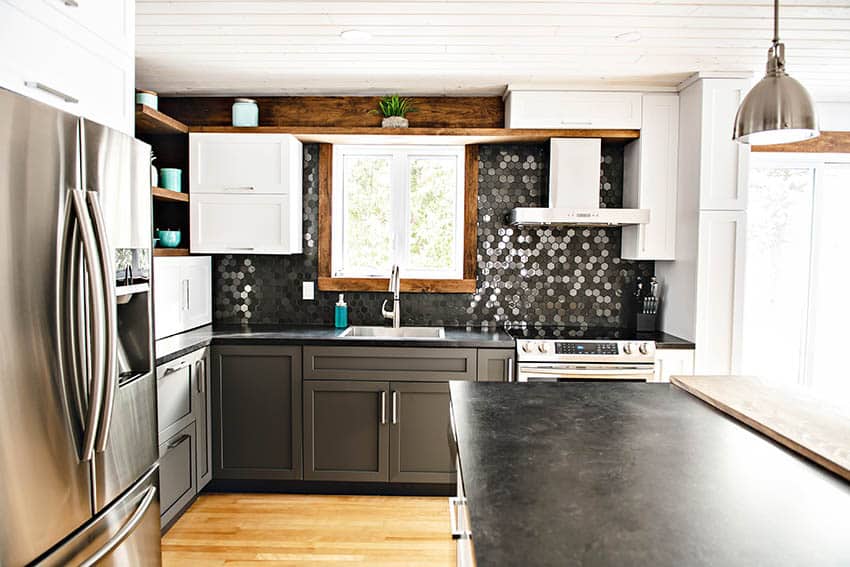
When it comes to replacing counters, price is a big factor. You need to keep in mind the price of both materials and installation to get an accurate price for the kitchen surfaces.
How Much Does a Slab of Slate Cost?
Slabs, in particular, costs about $75 to $200 per square foot installed. Typically a kitchen countertop is about 20 square feet in total; sometimes they are broken up into sections based on the locations of appliances. If the slabs are broken up into smaller pieces they can be on the lower end of the price range.
On average, for a slab kitchen countertop, one can expect the price to be around $1500 to $2500 depending on the design.
When looking at slab surfaces for bathrooms, those will have significantly less square footage dropping the price down significantly. These are commonly around 10 square feet, running about $1000 to $2000 total depending on the quality. This can change based on sink locations and bathroom size.
Which is Cheaper, Slate or Granite?

This natural stone is cheaper than granite. It is a great way to keep a beautiful, unique countertop at about half the cost.
A fully installed granite countertop could cost upwards of $4000 versus the mentioned $2000 for a slab countertop made of slates.
Both granite and marble are extravagant pieces of natural stone, but when it comes to price, slate takes the cake.
This material offers similar qualities as both marble, quartz and granite. You can find black granite, quartz and marble that looks similar to it.
With the lower initial cost as well as the high-quality material, this material offers the best return on investment (resale value) to the home when it needs to be sold.
Where to Buy Slate
These counters can be bought at a number of places. The easiest place to get such slabs is at your favorite local home improvement store.
To make it even easier you could even buy them online from the home improvement store, where you could set up delivery, installation, etc. These stores tend to have stock items, though, and while they can do custom items, there are still limitations on what they have and can get.
Specialty stone suppliers, custom fabricators, and local stone quarries also are sources of natural stone. Use these terms to search for businesses that sell the materials in your area.
Another way to buy these stone counters, especially when it is part of a larger project is to buy it from remodeling stores and contractors which also have online options. Start by asking questions at any of these stores and they will send you in the right direction.

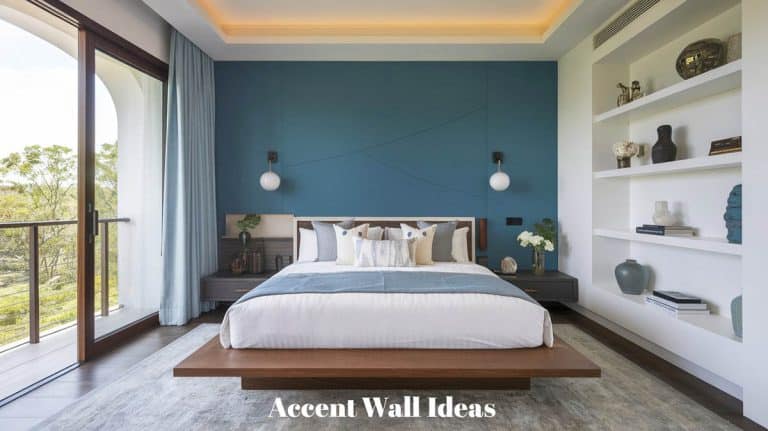
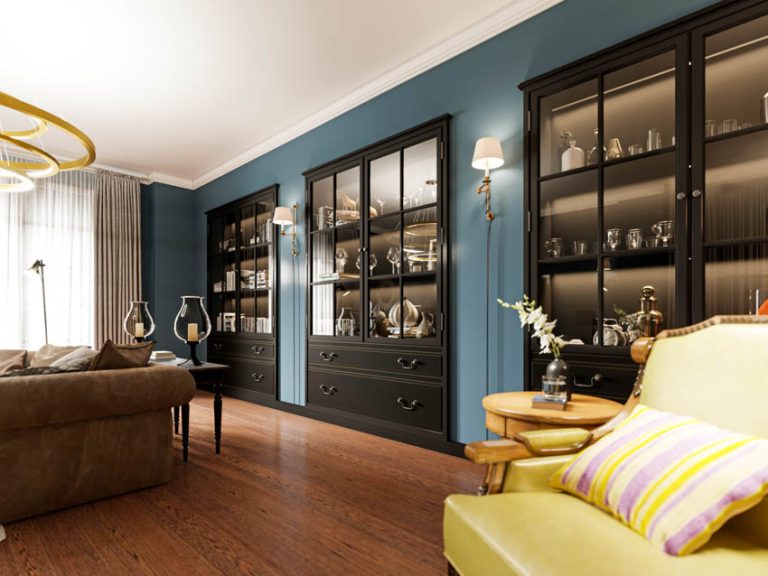
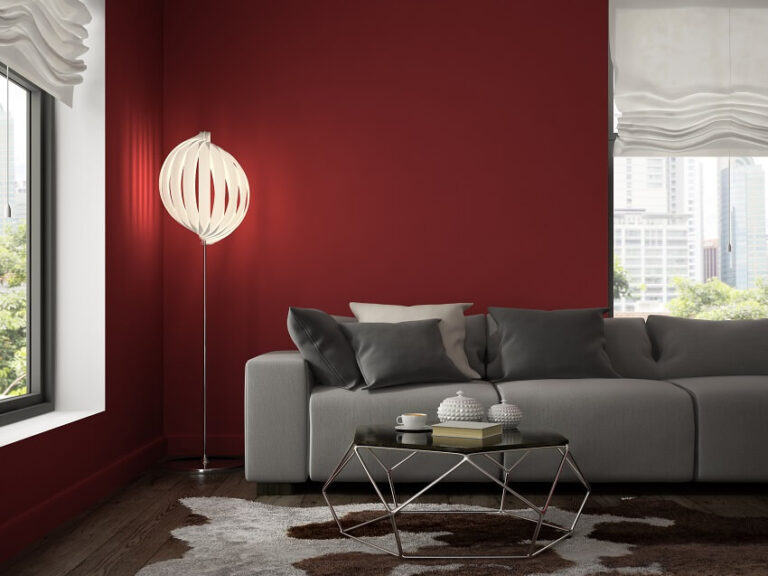
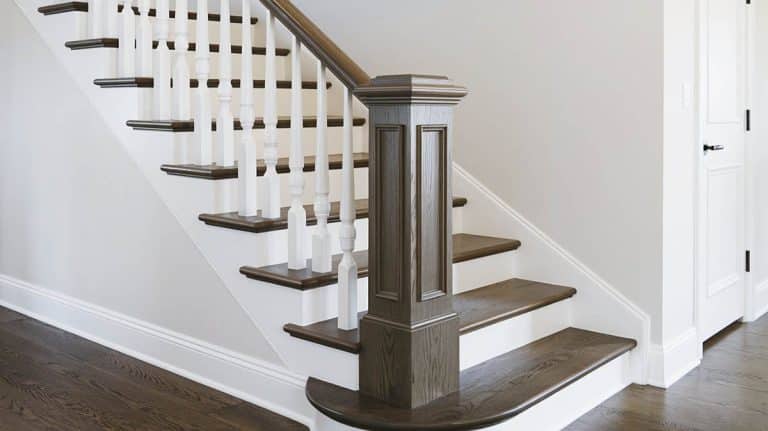

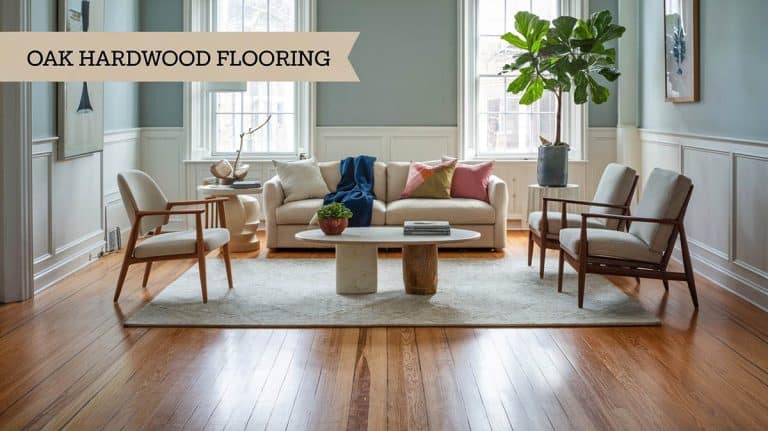
I just tried for quote from 3 large slate suppliers. For a 7 ft by 2 foot countertop with a sink cut-out and faucet hole, and 3 low backsplashes (4″ high to match 3 sides), the quotes are coming in at over $5k (yes, about $1.5k of that is shipping). But that’s just materials to my location…not installation. The math comes out to $275+ per square foot of cut/fabricated, but not installed, material. Yikes…that’s way more than your article estimates.
Hi Ben, thanks for the feedback. I’ll adjust the article accordingly. What area are you located in if you don’t mind me asking?